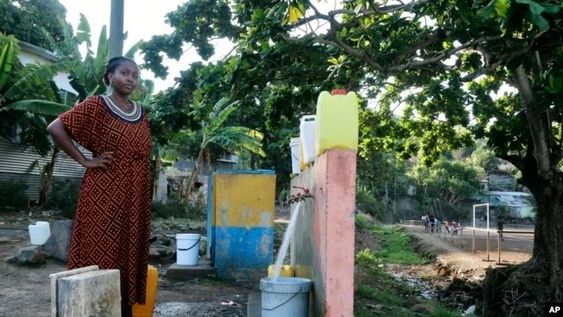Africa
Lack of investment and drought have left France’s poorest island dry

Water is becoming an increasingly valuable resource on the poorest island in the European Union, Mayotte, drop by disappearing drop. In this French enclave off the eastern coast of Africa, water only flows on one out of every three days due to a protracted drought that has been exacerbated by years of underfunding and poor water management.
Typhoid and cholera are on the rise, and the French army recently moved in to relieve supply-related tensions and distribute water. The situation serves as a warning to the French government about the difficulties and expenses involved in addressing climate change brought on by human activity over France’s vast areas.
When she can, 38-year-old Labatoir resident Racha Mousdikoudine uses bottled water to wash her dishes. She is a mother of two. She explains, “I have to choose between taking a shower and preserving my water supply” while the water taps run.
It will not be just a global scarcity in a few years. This is our chance to invite all French people to join us in solidarity. to be with us, to look for answers, and to bring attention to the Mayotte problem,” she remarked. “Because this can happen in all French departments.”
She is assisting in the organisation of the “Mayotte is Thirsty” protest movement, which calls for answers on purported embezzlement, leaks, and underfunding of sustainable water sources. Residents recently marched inside the Mayotte Water Management Company while singing, yelling, and banging empty plastic bottles.
Although locals argue that the impending rainy season won’t be sufficient to address the systemic water issues, the government is banking on it. During a crisis visit last week, the Mayotten people were commended by France’s minister for overseas territories for “accepting the unacceptable.”
In Mayotte, an island nation northwest of Madagascar home to around 350,000 people, the water taps dictate the rhythm of daily life.
Water flows between 4 p.m. and 10 a.m. every three days. Families run around doing dishes, cooking, cleaning, and every other task that involves water. People without plumbing in the less affluent areas of Mayotte wait up at public faucets with paint buckets, plastic jerrycans, recycled bottles, or anything else they can use to catch water.
They are dry again for 48 hours after that.
Mousdikoudine declared, “It is crucial to maintain communication with the authorities, but we won’t stand by and do nothing.” Politicians will continue to claim that the populace is strong and that we can handle this crisis if we remain at home. However, we are unable to accomplish this; our children’s lives, as well as their physical and emotional wellbeing, are in jeopardy.”
In Mayotte, where the majority population is Black and many are struggling migrants from neighbouring Comoros facing a fresh government crackdown, the most impoverished areas are the ones most severely affected by the water issue.
Water used to be one of Mayotte’s precious riches. Central Mayotte’s mountainous and forested Combani area is dotted with rivers and a plethora of springs. Eighty percent of the water on the island comes from the reservoirs in Combani and Dzoumogne, which are located further north.
READ ALSO: France and Nigeria Sign the $600 million I-DICE financing deal
The light is now creating cracks in the bare banks of the reservoir at Combani. Only 10% of its 1.75 million cubic metre capacity is currently used. The capacity of the Dzoumogne reservoir is 6.5%.
The national weather service reports that Mayotte is in its sixth year of drought and that this past year was the driest since 1997. In certain regions of the world, scientists claim that drought is becoming more common and severe due to human-caused climate change.
However, Mayotte’s water system was insufficient to meet local demands even in the absence of a drought.
850 leaks have been found since September, according to Overseas Affairs Minister Philippe Vigier, who made the announcement during a visit last week. Locals frequently record and post videos of Smae, a subsidiary of the large French utility Vinci, spouting water into voids in their water network management facilities.
As part of an ambitious water plan unveiled in September, known as the “Marshall Plan,” only one new borehole has been put into service thus far, providing a few hundred cubic metres of water per day.
Lack of production capacity, not a shortage of water, is the reason given by the local water union for the water rationing.
The federal government has committed to urgently digging for fresh springs, renovating a desalination facility, and expanding the state’s bottling programme to include all citizens, not just the most disadvantaged.
Locals have heard such promises in the past and are concerned that it won’t arrive quickly enough. There have already been years of delays, missing deadlines, and accusations of subsidies being pocketed at the desalination facility. This isn’t how things have to be.
The U.N. Development Programme is working on a $60 million water management project in the neighbouring Comoros, which has a comparable volcanic terrain with wet and dry seasons. The project’s goal is to better capture rainwater and track usage.
Comoros is among the world’s poorest nations, while France is among the richest and shouldn’t require assistance from the United Nations. However, the water situation in Mayotte highlights disparities and frequently uncomfortable relations between the French government in Paris and its former colonies.
Wealthier citizens of Mayotte spend 1,600 euros ($1,700) apiece to install personal water tanks, which guarantee constant water flow.
However, the majority of Mayotte’s population is below the French poverty threshold, so they have to pay attention to the government’s constant reminders that “every drop counts.” According to the state statistics agency Insee, 50% of people live on less than 160 euros ($170) per month, therefore most people cannot afford the 5.50 euros ($5.90) cartons of bottled water that are imported from mainland France.
Rather, they either drink nothing at all or brackish water. As crop production is reduced by the drought, hunger is also getting worse.
Medical professionals in the area report an increase in cholera, typhoid, and acute gastroenteritis, with 20 patients in intensive care for this condition in just one month.
However, Mayotte 1ère, a local broadcaster, was informed by Ben Issa Ousseni, president of the departmental council, that he thinks “the crisis is still ahead of us.”
He does not completely rule out the chance of a complete supply disruption in households.
